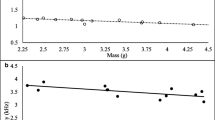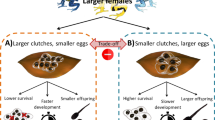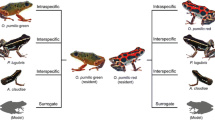Abstract
The evolution of aposematism is linked to increased opportunities for conspicuous sexual displays since detection by potential predators is no longer disadvantageous. Therefore, phenotypic divergence in aposematic species leading to relatively cryptic forms is expected to constrain such opportunities, by restoring the trade-off between natural and sexual selection on the boldness of sexual displays. We asked if and how a derived phenotype of the poison-dart frog Oophaga granulifera that appears relatively cryptic to potential predators exhibits conspicuous sexual displays for potential mates. We used visual modeling of frog contrasts against their natural backgrounds to test if for conspecifics green frogs appear less conspicuous than red frogs as they do for birds. We conducted behavioral observations of focal red and green males to determine if green frogs adjust their display behavior to the availability of potential mates. Dorsal brightness is known to influence female preferences in at least one poison frog species. We found that, despite being less visible under some measures, green frogs may appear as bright as red frogs for conspecifics but not birds, when viewed on dark backgrounds. Additionally, green males called more intermittently than red males when advertising to distant females, but they exhibited a dramatic increase in calling activity in proximity of a female and were as active as red males in this context. Together, our results suggest that green frogs retain context-dependent conspicuousness to conspecifics despite the evolution of relative crypsis to potential predators.






Similar content being viewed by others
References
Alvarado JB, Álvarez A, Saporito RA (2013) Oophaga pumilio (strawberry poison frog). Predation. Herpetol Rev 44:298
Andersson M (1994) Sexual selection. Princeton University Press, Princeton
Benjamini Y, Hochberg Y (1995) Controlling the false discovery rate: a practical and powerful approach to multiple testing. J R Stat Soc Ser B 57:289–300
Bolaños F (1990) Actividad de canto y territorialidad en Dendrobates granuliferus Taylor 1958, Costa Rica. Dissertation, Universidad de Costa Rica
Bonansea M, Vaira M (2012) Geographic and intrapopulational variation in colour and patterns of an aposematic toad, Melanophrynis cusrubriventris (Amphibia, Anura, Bufonidae). Amphibia-Reptilia 33:11–24
Brusa O, Bellati A, Meuche I, Mundy NI, Pröhl H (2013) Divergent evolution in the polymorphic granular poison-dart frog, Oophaga granulifera: genetics, coloration, advertisement calls and morphology. J Biogeogr 40:394–408
Byrne PG (2008) Strategic male calling behavior in an Australian terrestrial toadlet (Pseudophryne bibronii). Copeia 2008:57–63
Candolin U (1998) Reproduction under predation risk and the trade-off between current and future reproduction in the three spine stickleback. Proc R Soc Lond B 265:1171–1175
Crothers LR, Cummings ME (2013) Warning signal brightness variation: sexual selection may work under the radar of natural selection in populations of a polytypic poison frog. Am Nat 181:E116–E124
Crothers L, Gering E, Cummings M (2011) Aposematic signal variation predicts male-male interactions in a polymorphic poison frog. Evolution 65:599–605
Crump ML (1972) Territoriality and mating behavior in Dendrobates granuliferus (Anura: Dendrobatidae). Herpetologica 28:195–198
Cummings ME, Rosenthal GG, Ryan MJ (2003) A private ultraviolet channel in visual communication. Proc R Soc Lond B 270:897–904
DaCosta MA (2010) Phylogeny of Utetheisa s. str. (Lepidoptera: Noctuidae: Arctinae) with comments on the evolution of colour, hind wing scales and origin of New World species. Invertebr Syst 24:113–130
Darst CR, Cummings ME, Cannatella DC (2006) A mechanism for diversity in warning signals: conspicuousness versus toxicity in poison frogs. Proc Natl Acad Sci U S A 103:5852–5857
Dawkins MS, Guilford T (1996) Sensory bias and the adaptiveness of female choice. Am Nat 148:937–942
Development Core Team R (2009) R: a language and environment for statistical computing. R Foundation for Statistical Computing, Vienna
Endler JA (1987) Predation, light intensity and courtship behaviour in Poecilia reticulate (Pisces: Poeciliidae). Anim Behav 35:1376–1385
Endler JA (1991) Variation in the appearance of guppy color patterns to guppies and their predators under different visual conditions. Vis Res 31:587–608
Endler JA (1992) Signals, signal conditions, and the direction of evolution. Am Nat 139:S125–S153
Endler JA (2000) Evolutionary implications of the interaction between animal signals and the environment. In: Espmark Y, Amundsen T, Rosenqvist G (eds) Animal signals. Tapir, Trondheim, pp 11–46
Forsman A, Hagman M (2006) Calling is an honest indicator of paternal genetic quality in poison frogs. Evolution 60:2148–2157
Gittleman JL, Harvey PH (1980) Why are distasteful prey not cryptic? Nature 286:149–150
Godin JJ, McDonough HE (2003) Predator preference for brightly colored males in the guppy: a viability cost for a sexually selected trait. Behav Ecol 14:194–200
Goodman DE (1971) Territorial behavior in a Neotropical frog, Dendrobates granuliferus. Copeia 1971:365–370
Guilford T (1986) How do ‘warning colours’ work? Conspicuousness may reduce recognition errors in experienced predators. Anim Behav 34:286–288
Hart NS (2001) The visual ecology of avian photoreceptors. Prog Retin Eye Res 20:281–322
Håstad O, Victorsson J, Ödeen A (2005) Differences in color vision make passerines less conspicuous in the eyes of their predators. Proc Natl Acad Sci U S A 102:6391–6394
Ioannou CC, Krause J (2009) Interactions between background matching and motion during visual detection can explain why cryptic animals keep still. Biol Lett 5:191–193
Jones G, Barabas A, Elliott W, Parsons S (2002) Female greater wax moths reduce sexual display behavior in relation to the potential risk of predation by echolocating bats. Behav Ecol 13:375–380
Kålås JA, Fiske P, Saether SA (1995) The effect of mating probability on risk taking: an experimental study in lekking great snipe. Am Nat 146:59–71
Kotiaho J, Alatalo RV, Mappes J, Parri S, Rivero A (1998) Male mating success and risk of predation in a wolf spider: a balance between sexual and natural selection? J Anim Ecol 67:287–291
Maan ME, Cummings ME (2008) Female preferences for aposematic signal components in a polymorphic poison frog. Evolution 62:2334–2345
Maan ME, Cummings ME (2009) Sexual dimorphism and directional sexual selection on aposematic signals in a poison frog. Proc Natl Acad Sci U S A 106:19072–19077
Maan ME, Cummings ME (2012) Poison frog colors are honest signals of toxicity, particularly for bird predators. Am Nat 179:1–14
Magnhagen C (1991) Predation risk as a cost of reproduction. Trends Ecol Evol 6:183–186
Master TL (1999) Predation by Rufous Motmot on black-and-green poison dart frog. Wilson Bull 111:439–440
Merilaita S, Tullberg BG (2005) Constrained camouflage facilitates the evolution of conspicuous warning coloration. Evolution 59:38–45
Montanarin A, Kaeferand IL, Lima AP (2011) Courtship and mating behaviour of the brilliant-thighed frog Allobates femoralis from Central Amazonia: implications for the study of a species complex. Ethol Ecol Evol 23:141–150
Narins PM, Hödl W, Grabul DS (2003) Bimodal signal requisite for agonistic behavior in a dart-poison frog, Epipedobates femoralis. Proc Natl Acad Sci U S A 100:577–580
Pröhl H (2003) Variation in male calling behaviour and relation to male mating success in the strawberry poison frog (Dendrobates pumilio). Ethology 109:273–290
Pröhl H, Ostrowski T (2011) Behavioural elements reflect phenotypic colour divergence in a poison frog. Evol Ecol 25:993–1015
Reynolds RG, Fitzpatrick BM (2007) Assortative mating in poison-dart frogs based on an ecologically important trait. Evolution 61:2253–2259
Richards-Zawacki CL, Cummings ME (2011) Intraspecific reproductive character displacement in a polymorphic poison dart frog, Dendrobates pumilio. Evolution 65:259–267
Roithmair ME (1994) Male territoriality and female mate selection in the dart-poison frog Epipedobates trivittatus (Dendrobatidae, Anura). Copeia 1994:107–115
Roper TJ (1994) Conspicuousness of prey retards reversal of learned avoidance. Oikos 69:115–118
Roper TJ, Wistow R (1986) Aposematic colouration and avoidance learning in chicks. Q J Exp Psychol 38:141–149
Rudh A, Rogell B, Håstad O, Qvarnström A (2011) Rapid population divergence linked with co-variation between coloration and sexual display in strawberry poison frogs. Evolution 65:1271–1282
Rudh A, Breed MF, Qvarnström A (2013) Does aggression and explorative behaviour decrease with lost warning coloration? Biol J Linn Soc 108:116–126
Ryan MJ, Keddy-Hector A (1992) Directional patterns of female mate choice and the role of sensory biases. Am Nat 139:S4–S35
Savage JM (2002) The amphibians and reptiles of Costa Rica: a herpetofauna between two continents, between two seas. University of Chicago Press, Chicago
Siddiqi A, Cronin TW, Loew ER, Vorobyev M, Summers K (2004) Interspecific and intraspecific views of color signals in the strawberry poison frog Dendrobates pumilio. J Exp Biol 207:2471–2485
Silverstone PA (1973) Observations on the behavior and ecology of a Colombian poison-arrow frog, the kõkoé-pá (Dendrobates histrionicus Berthold). Herpetologica 29:295–301
Speed MP, Ruxton GD (2005) Aposematism: what should our starting point be? Proc R Soc Lond B 272:431–438
Speed MP, Brockhurst MA, Ruxton GD (2009) the dual benefits of aposematism: predator avoidance and enhanced resource collection. Evolution 64:1622–1633
Summers K, Weigt LA, Boag P, Bermingham E (1999a) The evolution of female parental care in poison frogs of the genus Dendrobates: evidence from mitochondrial DNA sequences. Herpetologica 55:254–270
Summers K, Symula R, Clough M, Cronin T (1999b) Visual mate choice in poison frogs. Proc R Soc Lond B 266:2141–2145
Trivers RL (1972) Parental investment and sexual selection. In: Campbell B (ed) Sexual selection and the descent of man, 1871–1971. Aldine, Chicago, pp 136–179
Vorobyev M, Osorio D (1998) Receptor noise as a determinant of colour thresholds. Proc R Soc Lond B 265:351–358
Vorobyev M, Osorio D, Bennett ATD, Marshall NJ, Cuthill IC (1998) Tetrachromacy oil droplets and bird plumage colours. J Comp Physiol A 183:621–633
Wang IJ (2011) Inversely related aposematic traits: reduced conspicuousness evolves with increased toxicity in a polymorphic poison-dart frog. Evolution 65:1637–1649
Wang IJ, Shaffer HB (2008) Rapid color evolution in an aposematic species: a phylogenetic analysis of color variation in the strikingly polymorphic strawberry poison frog. Evolution 62:2742–2759
Wells KD (2007) The ecology and behavior of amphibians. University of Chicago Press, Chicago
Willink B, Brenes-Mora E, Bolaños F, Pröhl H (2013) Not everything is black and white: Color and behavioral variation reveal a continuum between cryptic and aposematic strategies in a polymorphic poison frog. Evolution 67:2783–2794
Wing SR (1988) Cost of mating for female insects: risk of predation in Photinus collustrans (Coleoptera: Lampyridae). Am Nat 131:139–142
Zuk M, Kolluru GM (1998) Exploitation of sexual signals by predators and parasitoids. Q Rev Biol 73:415–438
Acknowledgments
We thank to A. Vicente, J. Shik, V. Acosta, and E. Arias for their valuable assistance in the field. The Rainmaker Park, The Firestone Center for Restoration Ecology and Hacienda Barú provided permits and logistic support. We are grateful to Thomas Cronin who kindly provided the sensitivity spectra for the photoreceptors of strawberry poison frogs and Nathan Hart who provided sensitivity spectra for the photoreceptors of blue tits. We thank G. Barrantes, E. Fuchs, J. Shik, C. Dreher, K. Knorr, Martine Maan, and one anonymous reviewer for comments that improved the manuscript.
Ethical standards
This study complies with current Costa Rican legislation and was conducted under research permits of the Ministerio de Ambiente, Energía y Telecomunicaciones of Costa Rica.
Conflict of interest
The authors declare that they have no conflict of interest.
Author information
Authors and Affiliations
Corresponding author
Additional information
Communicated by M. Gibbons
Electronic supplementary material
Below is the link to the electronic supplementary material.
ESM 1
(DOC 390 kb)
Rights and permissions
About this article
Cite this article
Willink, B., Bolaños, F. & Pröhl, H. Conspicuous displays in cryptic males of a polytypic poison-dart frog. Behav Ecol Sociobiol 68, 249–261 (2014). https://doi.org/10.1007/s00265-013-1640-4
Received:
Revised:
Accepted:
Published:
Issue Date:
DOI: https://doi.org/10.1007/s00265-013-1640-4




